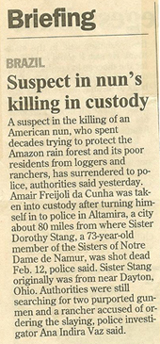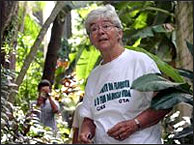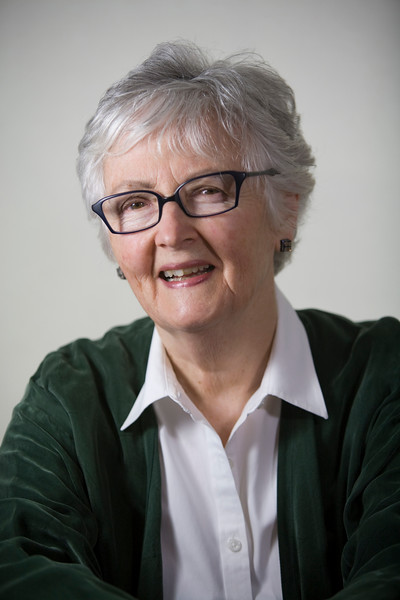How I came to write this book
 In February of 2005, I sat in my kitchen in Dobbs Ferry New York and watched the snow coming down. A Sunday morning, I perused the newspaper and found a small clipping about Sister Dorothy Stang, a Sister of Notre Dame de Namur.
In February of 2005, I sat in my kitchen in Dobbs Ferry New York and watched the snow coming down. A Sunday morning, I perused the newspaper and found a small clipping about Sister Dorothy Stang, a Sister of Notre Dame de Namur.
“Suspect in nun’s killing in custody”. The story first appeared in the Washington Post. . .Feb 20, 2005
As an aspiring mystery story writer I thought I might have found the right story on which to base my fiction tale. Who would do such a thing? I wondered. I would find out and craft a thriller.
I went to the Internet to find out more about this Sister of Notre Dame de Namur, a member of the same order of nuns, missionaries and teachers, who had taught at my college, Trinity, in Washington DC. From a life in a large German Irish family in Ohio, to an activist and a hero in the State of Pará Brazil this woman brought to light the untenable story of the peasants who were promised land to farm in the Amazon region in the early 1970’s.
I was naïve about this kind of cruelty and even more unknowing about the raging controversy in Brazil between ranchers, who sought lucrative livelihoods in the middle of the Amazon forest, and the farmer-settlers who eke out a living there. It was this conflict that brought about Dorothy’s death.

Sister Dorothy Stang
Her story moved me deeply – she put one determined foot in front of the other and her journey led to many successes in community building and environmental advocacy. As a child I listened to the Gospels instructing believers to care for the poor, to feed and clothe the hungry. As an adult I put my toe in the holy water of social justice, tutoring, helping in a soup kitchen, volunteering to teach immigrants English.
Suddenly, before me, on paper, there was a modern American woman who had taken a total immersion into that world and I wanted to know more about her and why and how she kept going.
Her tragic death was no mystery after all, but rather the result of greed and deep injustice in the forest of Brazil. And, the authorities knew who had pulled the trigger. I realized her story was too compelling to be fictionalized.
And, so, for the next three and a half years of research and multiple trips to the Ohio Province (Dorothy’s home) and to Brazil for the trial of the rancher, Bida, I wrote and rewrote A Journey of Courage, the Amazing Story of Sister Dorothy Stang.
Things fell into place – I was ready to retire from my business. A cousin whom I had taken care of left me some traveling money. The Sisters and the Stang family were open and gracious to me and to my project even when progress was slower than it could have been.
But there is more.
From the beginning, I felt as if the wind were at my back. From the first encouragement I got from my writing coach at Sarah Lawrence College, to finding the right book designer in Chapel Hill, I seem to have been meant to write this little tome and distribute it to carry on Dorothy’s message.
Dorothy’s story and my contact with the Sisters in Ohio and in Brazil, and her sisters and brothers here in the US, led me back to the Catholic Church. Like many American Catholics, I have problems with the autocracy, with some of the hypocrisy and the gender inequities implicit in the institution.

Sister Dorothy Stang
However, on a personal level, I had never given up faith, no matter what church I attended. I prayed simple prayers almost every night of my life while I took a hiatus from the Roman Catholic Church. I have now found a congregation where I feel comfortable and included.
There is a reason for the phrase, ”a leap of faith” because, there is no tangible reason for faith; some Christians attribute faith to the Holy Spirit. Dorothy simply believed and staked her life on that belief. She believed she could help people and she became a Sister. She believed she could build a school and teach children and she went to Arizona. She believed Pope John XXIII and she volunteered to go to Brazil to help those even poorer than the Mexican migrants she knew in Phoenix.
After reading about her death and hearing her story, first hand, from her family members, I was smitten and obsessed. I read, I researched, I travelled and met others who had known her. I am grateful to them all. The journey changed my life. It put me in close touch with an old and dear publishing friend. In addition, it plunged me into the lives of “new” sisters who travel in street clothes wearing only the cross of the Order and who believe that each life in Brazil or Cincinnati or Washington DC is worth improving. This to me is Christianity at its best and so I was moved to write about Sister Dorothy Stang.










